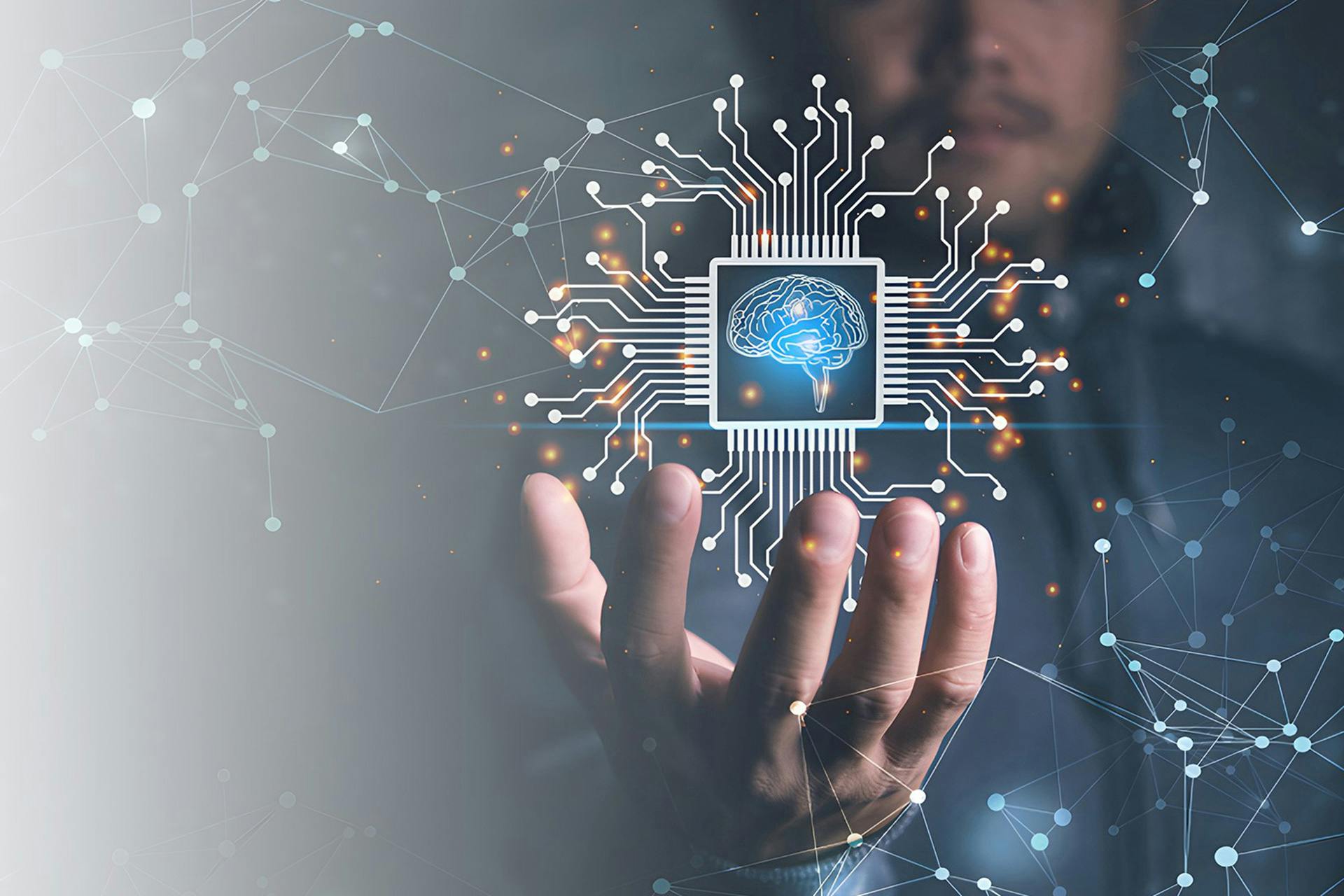
الإنتاج الذكيالذكاء الاصطناعي في التصنيع: ما هي أكبر الإمكانات حاليًا؟
التعرف على مجالات التطبيق المفيدة للذكاء الاصطناعي في المؤسسة
الشركات تبحث عن تطبيقات عملية
هذا العام، يبدو أن الذكاء الاصطناعي قد بدأ أخيرًا في تحقيق اختراق في السوق الشامل. لقد كان واضحًا لبعض الوقت أن الذكاء الاصطناعي سيغير الاقتصاد بعمق. وفقًا لإحصائية في عام 2018، من المتوقع أن يكون للذكاء الاصطناعي تأثير إيجابي كبير على الناتج المحلي الإجمالي.
في عام 2018، كانت مساهمة الذكاء الاصطناعي المقدرة في الناتج المحلي الإجمالي للولايات المتحدة حوالي 191 مليار دولار. من المتوقع أن يزداد هذا الرقم بشكل ثابت في السنوات القادمة. من المتوقع أن تصل مساهمة الذكاء الاصطناعي المقدرة إلى حوالي 515 مليار دولار في عام 2025، في حين يُتوقع أن تصل إلى حوالي 1.2 تريليون دولار في عام 2030.
لكن خاصة في مجال التصنيع، كانت التطبيقات العملية للذكاء الاصطناعي بطيئة في الانتشار. أحد الأسباب لذلك هو أن مجالات التطبيق المفيدة - أي المربحة - لا تزال نادرة. في استطلاع TÜV، قال 50% من الشركات أنهم لم يكونوا على دراية بأي استخدام مفيد للذكاء الاصطناعي في شركتهم؛ 42% كانوا غير واضحين بشأن ما يمكن أن يفعله الذكاء الاصطناعي لهم. كان ذلك في عام 2020 - من المحتمل أن تكون الأرقام قد تحسنت منذ ذلك الحين. ومع ذلك، في الإنتاج الضخم، لا تزال حالات الاستخدام العملي لم تُكتشف في كل مكان.
حالات استخدام الذكاء الاصطناعي في الإنتاج التي تقدم إمكانات كبيرة
أين يمكن استخدام تطبيقات الذكاء الاصطناعي في التصنيع لتحقيق تأثير جيد مع الوضع الراهن؟ في بعض المجالات، تحقق الذكاءات الاصطناعية الحالية الإمكانات لتحقيق مكاسب إنتاجية كبيرة، كما هو الحال في الأربعة التالية:
الروبوتات
معظم الروبوتات الصناعية حاليًا عمياء وغبية إلى حد ما. إنها تعمل وفقًا لقواعد مضمنة بشكل صارم. هذا يعمل لحجم كبير من الأجزاء في الإنتاج الضخم المعياري، مثل الروبوتات اللحامة في تصنيع السيارات.
ومع ذلك، عندما يختلف البيئة أو المنتجات أكثر، يجب على الروبوتات أن تصبح أكثر ذكاءً. على سبيل المثال، في إنتاج السلع الفردية وفي تجديد أو إعادة تدوير المنتجات المستخدمة. يمكن للروبوتات القائمة على الذكاء الاصطناعي أن تتعلم معاملة الأجزاء بشكل مختلف، على سبيل المثال، اعتمادًا على التصميم أو الحالة أو الاستخدام المقصود. حالة استخدام أخرى ممكنة للذكاء الاصطناعي هي انتقاء وإسقاط الأجزاء. يمكن للروبوت أن يمسك الأجزاء المخزنة بشكل عشوائي في الحاويات بشكل صحيح ويضعها مرة أخرى دون الحاجة إلى عمل تحضير يدوي.
تعمل ما يسمى بالروبوتات التعاونية أيضًا جزئيًا بالذكاء الاصطناعي. تشارك بيئة العمل مع البشر؛ تتحرك في الممرات، على سبيل المثال. للقيام بذلك، يجب أن تكون قادرة على فهم والتفاعل مع المواقف الحالية. يجب أن تكون قادرة على التنبؤ بالمخاطر والتكيف مع الأساليب المختلفة للعمل من قبل البشر.
مراقبة الجودة
يُعد التحكم في الجودة أحد المجالات التي تم نشر حلول الذكاء الاصطناعي فيها بنجاح منذ فترة. هذه المهمة مُفَتَرضة لقدرات الذكاء الاصطناعي وخاصة لمجال التعلم الآلي الشائع. بدلاً من تصنيف المكونات إلى جيدة وسيئة وفقًا لقواعد صارمة فحسب، يمكن للذكاء الاصطناعي اكتشاف وتقييم وتصنيف الانحرافات - حتى تلك التي تقع في مناطق حدودية. يمكن استخدام هذه القدرات، من بين أمور أخرى، لتقليل معدلات العيوب الزائفة أو إعداد كميات كبيرة من البيانات للتقييم بواسطة المفتشين البشريين.
اقرأ أيضًا: هل ممكن أن تكون خطوط اللحام ذاتية التحسين مع الذكاء الاصطناعي؟
تخطيط الإنتاج
يجب أخذ عوامل كثيرة في الاعتبار في تخطيط وجدولة الإنتاج: حالة الطلب، نوع وكمية المواد المطلوب تصنيعها، تواريخ التسليم، المخزون، الأسعار وتوافر المواد الخام والقطاعات نصف المصنعة، توافر البشر والآلات، وهكذا. مما يجعل المهمة معقدة جداً.
يمكن للبرمجيات المستندة إلى الذكاء الاصطناعي تقييم الكثير من البيانات في الوقت الحقيقي وتقديم توصيات للتخطيط. يمكنها أيضًا دمج بيانات إضافية، مثل بيانات السوق الحالية، ومؤشرات الصناعة، أو البيانات التاريخية عن سلوك طلب الزبائن. باستخدام الذكاء الاصطناعي، يمكن للمخططين محاكاة سيناريوهات مختلفة وإنشاء توقعات لاتخاذ قرارات أفضل.
معايرة الآلات
للتاكد من حجم الدفعات الصغيرة أو المنتجات المُخصصة، يجب تعديل وتنظيم المعايير لكل آلة إنتاج. مع وجود عشرات المعايير، يؤدي ذلك إلى انقطاعات طويلة. بالإضافة إلى أنه بالنسبة للقطع التي يتم إنتاجها بشكل غير متكرر، غالبًا ما يكون هناك نقص في التجربة، ويجب العثور على الإعداد المثالي أولاً.
يمكن للذكاء الاصطناعي تبسيط هذا الجزء. على سبيل المثال، يتعرف على أوجه التشابه بين المنتجات ويقترح الإعدادات المناسبة. أو أنه يحسب التكوين المثالي العام بناءً على بعض المعايير المحددة مُسبقًا.
تحديد المناطق المربحة لتطبيق الذكاء الاصطناعي
ما هي الطريقة الأفضل للشركات لتحديد المناطق المربحة لتطبيق الذكاء الاصطناعي؟ يجب أن تأتي الحافز من قسم الأعمال، الذي يعرف العمليات والمشاكل. المشاريع التي يقودها التكنولوجيا فحسب - "يجب علينا عمل شيء ما باستخدام الذكاء الاصطناعي" - غالباً ما تُحكم بالفشل.
يجب على المسؤولين تحليل عملياتهم الخاصة: أي المهام تكرارية؟ أي المهام هي نسبياً رتيبة وبالتالي تشكل تحدياً للبشر بمرور الوقت؟ من الناحية المبدئية، مثل هذه العمليات مفروضة لاستخدام الذكاء الاصطناعي. لكن العمل المعرفي الرقمي يمكن أن يتم أتمتته بشكل متزايد أو على الأقل دعمه بواسطة الذكاء الاصطناعي.
ومع ذلك، يجب أن تكون العوامل الأخرى صحيحة أيضًا: كلما زادت الواجهات التي يمتلكها النظام، كان الأمر أكثر تعقيدًا. النظم المعزولة، من ناحية أخرى، مثالية، مثل مناطق التحكم في الجودة أو الروبوتات الموضحة أعلاه. ثم يجب أن يكون لدى الشركات بيانات التدريب اللازمة لنماذج الذكاء الاصطناعي؛ تعتمد نجاحات الحل المميز للذكاء الاصطناعي بشكل رئيسي على ذلك.
وأخيراً، تحتاج الشركات إلى الخبرة والعاملين المهرة اللازمين للتنفيذ. في استطلاع TÜV المذكور، ذكر 40٪ هذين الجانبين كالعقبات الأكبر لاستخدام الذكاء الاصطناعي بشكل أكبر. إذا حددت الشركات مناطق تطبيق ذات معنى لنفسها ، فلا يجب أن يفشل هذا على الأقل: تقدم معاهد البحث ومقدمو الخدمات العديد من نماذج الذكاء الاصطناعي العامة والمعدة جزئياً وتقديم الدعم أثناء التنفيذ.
نشكر الدعم الودي في إعداد هذا المقال:
معهد فراونهوفر للهندسة والإنتاج الآلي IPA
الأستاذ الدكتور ماركو هوبر، رئيس قسم الذكاء الإدراكي السيبراني
السيد مي ت. شتال، مدير مشروع/طالب دكتوراه قسم تطوير الاستراتيجية للشركات
الخلاصة
باختصار:
- لم تجد العديد من الشركات حتى الآن حالات استخدام مربحة للذكاء الاصطناعي في التصنيع.
- في بعض المجالات، كانت حلول الذكاء الاصطناعي قيد الاستخدام الإنتاجي لبعض الوقت، مثل في مراقبة الجودة أو الروبوتات.
- عمليات التكرار العالية تقدم حاليًا أكبر إمكانات لاستخدام الذكاء الاصطناعي.
